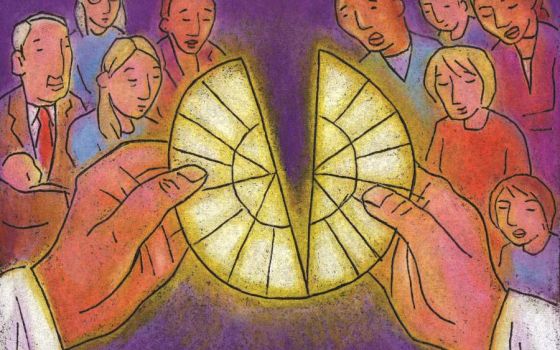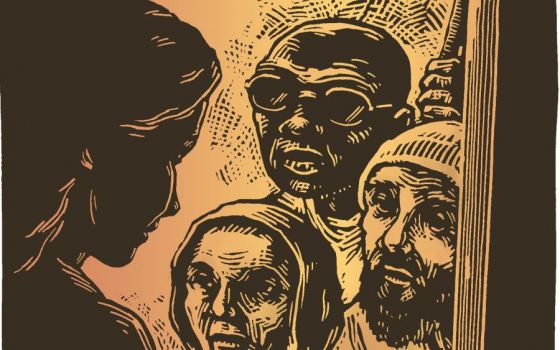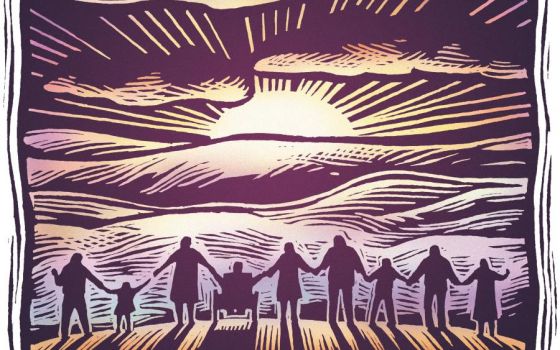
(Julie Lonneman)
"To the tombs I went to mourn the hope I thought was gone. Here among you I awoke to unexpected dawn."
So begin the fifty days of the Easter season in my parish community, and I suspect in many others as well. Rory Cooney's magnificent hymn "Jerusalem My Destiny" sends us forth from the Easter Vigil trumpeting the good news of the Paschal Mystery. In singing it, we proclaim what the early Acts community knew so very well: "No one walks alone. The journey makes us one."
There are many Easter mornings when I arrive for the 7:30 Mass with a sense that the anticipated morning celebrations are anticlimactic. The real celebration, the Vigil, ended only a few hours earlier. But soon the church fills to overflowing at all three Easter morning liturgies, defying my sense of things. And it is, as they say, all good. Still, one hopes for the time when the church is packed beyond capacity on Easter Saturday as the community of faith welcomes the catechumens and celebrates the extraordinary liturgy of the Easter Vigil. Our hope is born of slow change and reawakened awareness of the catechumenate's importance to the life of the church.
But if we hope and believe that the Vigil is slowly gaining recognition as the most important event of the church year, the post-baptismal period of the Easter season is another story. For these designated fifty days are veritably unknown and nearly ignored by all except liturgists, catechumenate directors and their groups of neophytes. The folks in the pew think Easter is the end of a season rather than a beginning. And the term the church uses to describe these fifty days, mystagogia, is a stumbling block in and of itself.
So why should a parish community pay attention to these fifty days? In the early church, some records suggest that the entire community spent that first week with the newly baptized listening to their experiences of baptism, confirmation and Eucharist. It was the occasion for a massive community retreat, if you will. But that was centuries ago and it was a fledgling community that is a far cry from the church we are today. So what about mystagogia now?
According to the Rite for the Christian Initiation of Adults, the time of mystagogia is the period of time in which "the community and the neophytes move forward together, meditating on the Gospel, sharing in the Eucharist, and performing works of charity. In this way they understand the Paschal Mystery more fully and bring it into their lives more and more" (#37).
The statement reminds us of faith's foundational sources of grace: the Eucharist, the scriptures and acts of charity (and justice, I might add). More, the directives of the rite make two things very clear: The fifty days are not intended for the neophytes alone, but rather as a time for shared reflection and action with the entire community. And all that we do in those fifty days should draw us more deeply into the Paschal Mystery.
What then might we do? Can we find ways to bring people together in these early weeks to savor the mysteries of faith — at lunch-and-listen or morning-Mass-and-coffee sessions, at work at a soup kitchen, or inviting a neophyte to small faith groups that continue during the fifty days?
Advertisement
Do we preach about the significance of mystagogia, explaining the word in language that invites a community's reflection? Perhaps we focus on making the connection that dying and rising occurs daily in the rhythm of family life. Whether birthing a child, marrying a spouse, changing a job, accepting an aging body or downsizing belongings to move from the family home, we can hold on to the truth that death indeed leads to life. Perhaps we remind ourselves that seeking the common good, rather than individual gain, is what it means to live the Paschal Mystery. Or that opening our hearts to the immigrant, the prisoner, the poor and disadvantaged does not diminish us as a people but is the real source of abundant life.
These fifty days are a community's time to reflect and to claim the Paschal Mystery as alive in its midst. The period of mystagogia counters the cultural view that Easter is over when the decorations leave the stores on Easter Monday. And it may challenge our own perspectives that we cannot do one more thing after the rigors of Lent and the exhausting work of the Triduum. But think again. Even when Pentecost comes, it doesn't end. For really, the journey is for life. We just have a larger group of folks with whom to share it.
Editor's note: This reflection was originally published in the May 2012 issue of Celebration. Sign up to receive daily Easter reflections.








